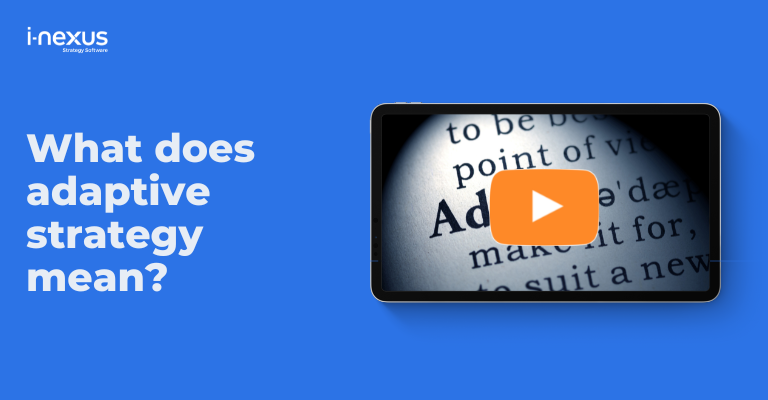From theory to execution, managing your strategy is made possible through well-practiced frameworks which bring a plethora of benefits to your business. Here's all you need to know about the frameworks and benefits associated with Strategy Execution Management.
Written by: James Milsom, Head of Marketing
With the trinity of strategy formulation, implementation and execution set in motion in your organization, exceptional results and outperforming the market can, indeed, become more likely.
But, we would be remiss to not mention the role of management theory and frameworks across our Strategy Execution Management content collection.
Although we have written before about the perils of agonizing over theory, that was not to discredit the importance of academics.
In fact, one theory stands out from a sea of intellectuals, and that is Chaffee’s linear vs adaptive strategy.
Linear strategy
Linear strategy focuses on sequences. Goals lead to actions and actions lead to results. Results are measured and these feed new goals.
This form of Strategy Execution Management is prescriptive. It leaves little room for creativity or input from those executing the strategy.
Though perhaps deductive, it translates strategic management into little more than a tick box exercise.
It is this line of thinking which influences leaders to approach implementation and execution in an autocratic manner.
A singular focus on the process of Strategy Execution Management is assumptive that strategy is formed and executed in a stable environment.
The decade so far has proven anything but.
Adaptive strategy
Adaptive strategy concerns itself with change – organizational processes, structures, skill set and resources.
The change is necessitated by the external environment, which is also the reason for strategic formulation in the first case.
This mindset largely reflects modern management, but why?
At its core, adaptive Strategy Execution Management is engaging and rewarding.
Indeed, leaders take ultimate responsibility for performance, but there is a shared passion here.
That is secured through effective communication, participatory techniques such as catchball, and an implied contract between employer and employee to contribute to success.
However, your organizational culture must be one in which this theory can succeed – meaning one of openness, trust, learning and collaboration.
Who is responsible for Strategy Execution Management?
Strategy Execution Management can be seen as the ‘responsibility’ of the entire organization. After all, every employee has something to contribute to the picture of success.
But, that responsibility is implied. No one person wakes up in the morning with the intention to not contribute to the success of their organization.
In terms of who is ultimately looked at as the guardians of strategy, this is split between individuals and offices:
| Individuals | Offices |
| CEO | C-Suite |
| CSO | Strategy Realization Office |
| COO | Enterprise Project Management Office |
| VP of Strategy | Project Management Office |
| Program Managers | Business Excellence Office |
| Project Managers | Business Improvement Office |
| Team Leaders |
What frameworks, tools and software are used?
Strategy Execution Management involves a staggering number of frameworks, tools and software, below are some suggestions that you could use in your organization.
Frameworks
- MBO
- 4DX
- BSC
- OGSM
- OKR
- Hoshin Kanri
Tools
- Vision statement
- Gap analysis
- SWOT
- Porter's Value Chain
- Strategy Canvas
- Business Model Canvas
- PESTEL
- VRIO
- McKinsey 7S
- Porter's 5 Forces
- Pareto Analysis
Software
- BaseCamp
- Excel
- PowerPoint
- Zoom
- i-nexus
- PowerBI
- Employee benefits, rewards and incentives (e.g. through vendors such as Perkbox or Sodexo Engage)
What are the benefits of successful Strategy Execution Management?
While the advantages of successful Strategy Execution Management have been littered throughout, they can be summarized as follows:
- Increased resource utilization
- Higher ROI on initiatives and benefit realization
- Awareness and navigation of risks (internal and external)
- A balanced and monitored project portfolio
- An introduction of stability over earnings through data-driven analysis and financial planning
- Motivation of your organization with effective communication, participation and rewards
- Upskilling and lowering staff churn rate with opportunities to learn and develop in areas such as Six Sigma and Lean
- Showcasing people throughout your organization for their creativity and commitment to excellence
- A focus on growth in a sustainable manner – joining objectives, people, resources and systems to one goal – your strategy
Focus and determination to succeed
Strategy Execution Management is absolutely challenging.
But it is in the same breath tantalizingly rewarding and the benefits tangible.
Strategy Execution Management will never be a quick-fix. It cannot provide you with overnight success because, by its very nature, overnight success is spontaneous.
This is something very different.
Formulating, implementing, executing and reviewing your strategy requires a tremendous orchestration of hearts, minds and systems across your organization.
But, with measured action, commercial awareness and a motivated, engaged team, you can take great strides to becoming a master of Strategy Execution Management.
What will your next steps be in Strategy Execution Management?
Click here to visit our Strategy Execution Management knowledge hub, filled with content to support you in embracing the 'no normal' of strategy in the 2020s and beyond, or explore these recommendations:
- Strat to Action – Developing a countermeasure culture: Watch our on-demand presentation of how you can guide your business towards using data and countermeasures to drive strategic success.
- How AI and machine-assisted learning will help your Strategy Execution: As Artificial Intelligence becomes a mainstay in our lives, read how AI and machine-assisted learning will evolve to support your Strategy Execution.
- Download our Key to Strategy Execution eBook: Read how companies like Danaher and HP have mastered Strategy Execution Management and what you can learn from them.
About the author
James Milsom is Head of Marketing at i-nexus. James has wide-ranging experience in markets such as telecommunications, energy, education, and software.
As Head of Marketing, his drive is to raise awareness and understanding of the challenges facing enterprises in delivering strategic objectives and transformation amidst changing markets and the obstacles traditional tools and methods present leaders.
If you’d like to talk more about Strategy Execution, reach out to James on james.milsom@i-nexus.com or connect with him on LinkedIn for the latest insights.



